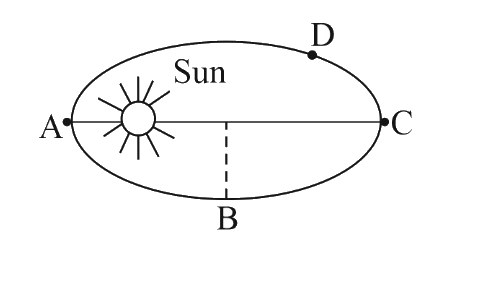Kepler's third law states that square of period revolution (T) of a planet around the sun is proportional to third power of average distance i between sun and planet i.e. T2=Kr3
here K is constant
if the mass of sun and planet are M and m respectively then as per Newton's law of gravitational the force of alteaction between them is F=GMmr2, here G is gravitational constant. The relation between G and K is described as
GK=4π2
GMK=4π2
K=G
K=1G
The correct Answer is:B
To derive the relationship between the gravitational constant G and the constant K in Kepler's third law, we can follow these steps:
1. Understanding Kepler's Third Law:
Kepler's third law states that the square of the period of revolution T of a planet around the sun is proportional to the cube of the average distance r between the sun and the planet. This can be expressed mathematically as:
T2=Kr3
where K is a constant.
2. Using Newton's Law of Gravitation:
According to Newton's law of gravitation, the gravitational force F between two masses M (mass of the sun) and m (mass of the planet) separated by a distance r is given by:
F=GMmr2
where G is the gravitational constant.
3. Relating Gravitational Force to Circular Motion:
For a planet in circular orbit, the gravitational force provides the necessary centripetal force for the planet's circular motion. The centripetal force Fc is given by:
Fc=mv2r
where v is the orbital speed of the planet.
4. Setting Gravitational Force Equal to Centripetal Force:
Setting the gravitational force equal to the centripetal force gives:
GMmr2=mv2r
We can cancel m from both sides (assuming m≠0):
GMr2=v2r
Multiplying both sides by r:
GMr=v2
5. Relating Orbital Speed to Period:
The orbital speed v can also be expressed in terms of the period T:
v=2πrT
Squaring both sides gives:
v2=(2πrT)2=4π2r2T2
6. Substituting for v2:
Now substitute v2 back into the equation:
GMr=4π2r2T2
7. Rearranging the Equation:
Rearranging gives:
T2=4π2r3GM
8. Comparing with Kepler's Third Law:
From Kepler's third law, we have T2=Kr3. By comparing both equations, we find:
K=4π2GM
9. Final Relationship:
Rearranging this gives the relationship between G and K:
GMK=4π2
Summary:
The relationship between the gravitational constant G and the constant K in Kepler's third law is given by:
GMK=4π2
Kepler's third law states that the square of the period of revolution T of a planet around the sun is proportional to the cube of the average distance r between the sun and the planet. This can be expressed mathematically as:
T2=Kr3
where K is a constant.
According to Newton's law of gravitation, the gravitational force F between two masses M (mass of the sun) and m (mass of the planet) separated by a distance r is given by:
F=GMmr2
where G is the gravitational constant.
For a planet in circular orbit, the gravitational force provides the necessary centripetal force for the planet's circular motion. The centripetal force Fc is given by:
Fc=mv2r
where v is the orbital speed of the planet.
Setting the gravitational force equal to the centripetal force gives:
GMmr2=mv2r
We can cancel m from both sides (assuming m≠0):
GMr2=v2r
Multiplying both sides by r:
GMr=v2
The orbital speed v can also be expressed in terms of the period T:
v=2πrT
Squaring both sides gives:
v2=(2πrT)2=4π2r2T2
Now substitute v2 back into the equation:
GMr=4π2r2T2
Rearranging gives:
T2=4π2r3GM
From Kepler's third law, we have T2=Kr3. By comparing both equations, we find:
K=4π2GM
Rearranging this gives the relationship between G and K:
GMK=4π2
The relationship between the gravitational constant G and the constant K in Kepler's third law is given by:
GMK=4π2
Similar Questions
When a planet moves around the sun
View SolutionPlanet nearest to sun is
View SolutionExplain the motion of a planet around the sun in a circular path?
View SolutionState Newton.s law of gravitation. Distinguish between g and G.
View SolutionKepler's law starts that square of the time period of any planet moving around the sun in an elliptical orbit of semi-major axis (R) is directly proportional to
View SolutionIf the distance between earth and sun is increased by 2 % , then find percentage change in gravitational force acting between them .
View SolutionThe time of revolution of planet A round the sun is 8 times that of another planet B. The distance of planet A from the sun is how many times the distance of B from the sun
View SolutionA planet revolves around the sun in an elliptical . The linear speed of the planet will be maximum at

View SolutionDuring motion of a planet from perihelion to aphelion the work done by gravitational force of sun on it is
View SolutionWhich planet is farthest to Sun ?
View Solution